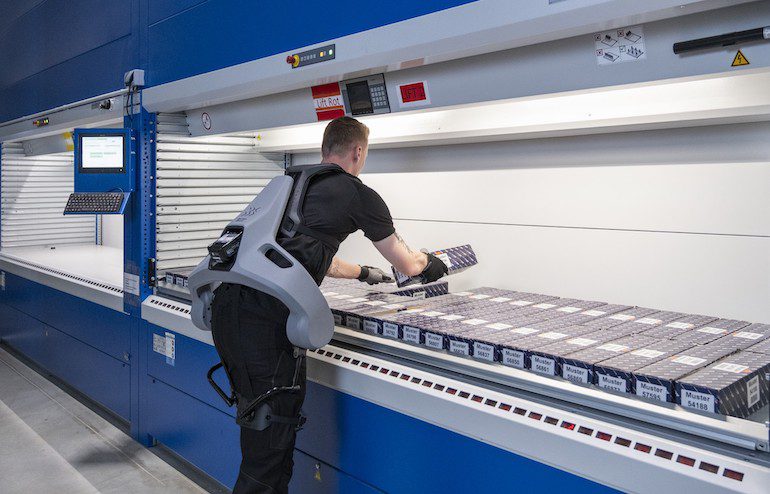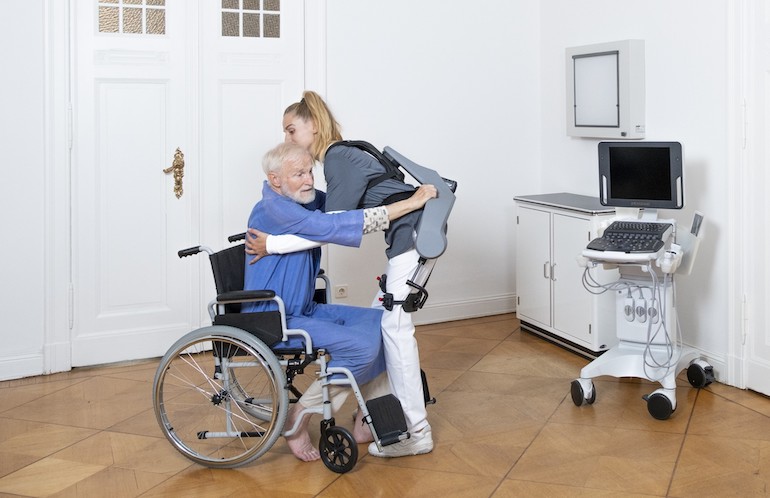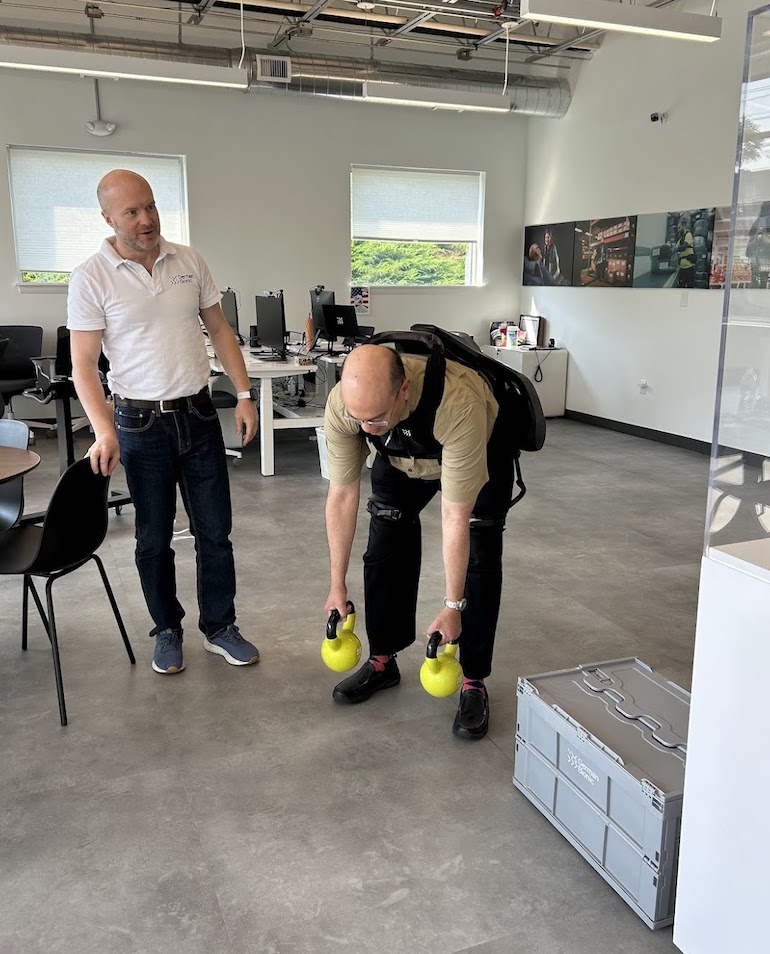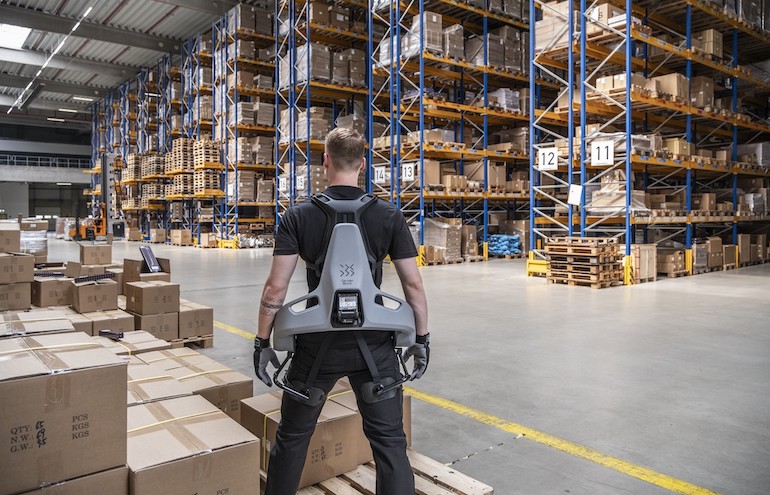
Exia can help production-line workers avoid repetitive stress. Source: German Bionic
German Bionic Inc. today launched Exia, which it claimed is “the world’s first exoskeleton powered end to end by true augmented AI.” The company said its most advanced wearable system yet is designed to meet the demands of virtually any industry.
“Exia represents a breakthrough in human augmentation,” stated Armin G. Schmidt, co-founder and CEO of German Bionic. “It’s built not only on years of engineering excellence and the lived experiences of countless workers who already rely on our technology, but also on a foundation of billions of real-world data points.”
“Exia doesn’t merely respond or even just think – it actually learns,” he added. “With every movement, it grows alongside its user, continuously adapting and evolving to meet the demands of the person and the job at hand.”
Founded in 2017, German Bionic has developed active exoskeletons to enhance the physical capabilities of workers. The company said it is committed to improving workplace safety, productivity, and well-being through its innovative systems.
“Ten years ago, exosuits were bulky and expensive,” Schmidt told The Robot Report. “The market wasn’t ready, but there are now numerous use cases.”
Berlin-based German Bionic has offices in Augsburg, Germany; Burlington, Mass.; Paris; and Tokyo and manufacturing around the world. It is represented in North America by its exclusive distribution partner KULR Technology Group Inc.

Now accepting session submissions!
German Bionic designs for strength, smarts
“Exia sets a new benchmark for strength, intelligence, and adaptability,” asserted German Bionic.
The system includes a next-generation hardware architecture and optimized control software. The company redesigned its industrial exoskeleton to be lighter and to provide up to 84 lb. (38 kg) of dynamic lift assistance.
German Bionic added that its artificial intelligence is informed by billions of real-world motion data points collected across industries including manufacturing, logistics, retail, and healthcare.
“Our exoskeletons serve a lot of hospitals in Germany,” said Schmidt. “We’ve had positive feedback from patients, who don’t feel like a burden to nurses.”
“Using its real data, Exia can anticipate user needs and optimize support in real time,” German Bionic said. “Learning from a wearer’s actions and environment, it interprets movement patterns, understands context, and adjusts instantly to provide the most effective support – whether lifting, walking, bending, or carrying.”

Exia combines an exoskeleton and AI to serve multiple industries, such as healthcare. Source: German Bionic
Exia includes AI to address industry challenges
German Bionic said that Exia can tackle some of the biggest productivity and and budgetary challenges facing industry today. Musculoskeletal disorders — injuries from heavy living and repetitive strain — reportedly cost U.S. employers more than $67,000 per claim on average.
In addition, experts predict that by 2033, the U.S. could be short 1.9 million manufacturing workers. Businesses need to make physically demanding roles safer, more sustainable, and more appealing to secure a stable and capable workforce, according to German Bionic.

Armin Schmidt, CEO of German Bionic, and editor Eugene Demaitre demonstrate the Apogee exoskeleton. Credit: The Robot Report
“The software side is critical to making exoskeletons more usable and accepted,” noted Schmidt. “Our controller and software make the motion extremely smooth, and the human always has control and is never overruled.”
Exia continually learns, thanks to its AI-native architecture and over-the-air (OTA) software updates, the company said. The device can fine-tune its behavior to individual wearers and specific tasks, becoming even more precise and more effective over time, it said.
By reducing injury risk, increasing productivity, and extending career longevity in physically demanding roles, German Bionic said Exia can help companies protect their current workforces and attract the next generation of skilled labor.
Other industries expressing interest in German Bionic’s exoskeletons include construction and food handling, Schmidt said. The company provides its systems through a robotics-as-a-service (RaaS) and software-as-a-service (SaaS) model.
Key exoskeleton features:
- Adaptive lift engine: Learns each user’s movement and delivers precisely timed support up to 84 lb. (38 kg)
- Smart safety companion: Real-time digital twin flags high-risk motions and encourage safe practices
- German Bionic Connect app: Empowers users with settings control, usage analytics, and gamified coaching on any smartphone
- German Bionic IO: Advanced cloud analytics platform delivering ergonomic insights, activity monitoring, and fleet management through a user-friendly dashboard
Connect to enhance the user experience
The Connect app comes with all German Bionic exoskeletons, providing detailed performance metrics such as steps taken, weight lifted, and usage time. The app provides two-way communications, fostering engagement by allowing users to share direct feedback and qualitative insights.
The company explained that this continuous input loop delivers a personalized, evolving experience tailored to each user’s needs. German Bionic’s app is intended to promote a sense of ownership, support workplace safety, and encourage user acceptance.
Together with the Connect app and the exoskeletons, German Bionic’s 360° Human Augmentation approach includes the German Bionic IO data-insights platform and additional human-machine interfaces. This integrated system enables real-time ergonomic assessments, activity monitoring, and detailed reporting.
The data is accessible through a user-friendly dashboard. It is complemented by a video-based Academy, which offers onboarding tutorials and expert Pro Tips to enable wearers to take full advantage of the exoskeleton.

Exia learns from worker movements and provides a two-way user interface. Source: German Bionic
Exia attains new levels of augmentation
“Exia marks a pivotal moment in the evolution of wearable robotics,” boasted German Bionics. “By harnessing the power of true augmented AI and training on billions of real-world data points, it delivers a level of intelligence and responsiveness never before seen in exoskeleton technology.”
“An exoskeleton should be like a second skin. We believe in active, powered suits, which augment humans like an e-bike,” said Schmidt. “The best feedback we’ve had is from a worker who told us that he can now go home and play with his kids because he’s not too tired from work.”
Exia is available for North American pilot and fleet orders from today onward from the company and its authorized partners.
